Abstract
Possible protective effects of the agonist [D-Trp6]LH-RH (analog of luteinizing hormone-releasing hormone in which Gly-6 is replaced by D-tryptophan) and antagonist N-Ac-[D-Phe(pCI)1,2,D-Trp3,D-Arg6,D-Ala10]LH-RH against testicular damage caused by x-radiation were investigated in rats. Three months after being subjected to x-irradiation of the testes with 415 or 622 rads, control rats showed marked reduction in the weights of the testes and elevated levels of LH and follicle-stimulating hormone (FSH), indicating tubular damage. Histological studies demonstrated that, in testes of rats given 415 rads, most seminiferous tubules had only Sertoli cells and no germinal cells, and, in the group given 622 rads, the depression of spermatogenesis was even more marked. Rats pretreated for 50 days with LH-RH antagonist (1000 micrograms/kg of body weight per day) showed a complete recovery of testicular weights and spermatogenesis 3 months after 415 rads and showed partial recovery after 622 rads, and LH and FSH levels returned to normal in both of these groups. Thus, pretreatment of rats with LH-RH antagonist, by reversibly inhibiting gonadal function, protected the germinal cells of the testes against damaging effects of x-rays. Three experiments were also carried out in which the rats were pretreated for 1-2 months with long-acting microcapsules of the agonist [D-Trp6]LH-RH, liberating 25 micrograms of the agonist per day. Some rats were then subjected to gonadal irradiation with 415 or 622 rads and allowed a recovery period of 2-4 months. In spite of pretreatment with [D-Trp6]LH-RH, testicular weights were significantly lower and LH or FSH levels were elevated in the irradiated groups as compared with nonirradiated controls. The recovery of spermatogenesis was incomplete, and there was a decrease in the number of germinal cells after 415 rads and especially after 622 rads. On the basis of testicular weights, histology, and gonadotropin levels, it could be concluded that the agonist [D-Trp6]LH-RH did not protect the rat testes exposed to 622 rads and, at most, only partially protected against 415 rads. These results suggest that pretreatment with LH-RH antagonists and possibly agonists, might decrease the testicular damage caused by radiation and accelerate the recovery of reproductive functions.
Full text
PDF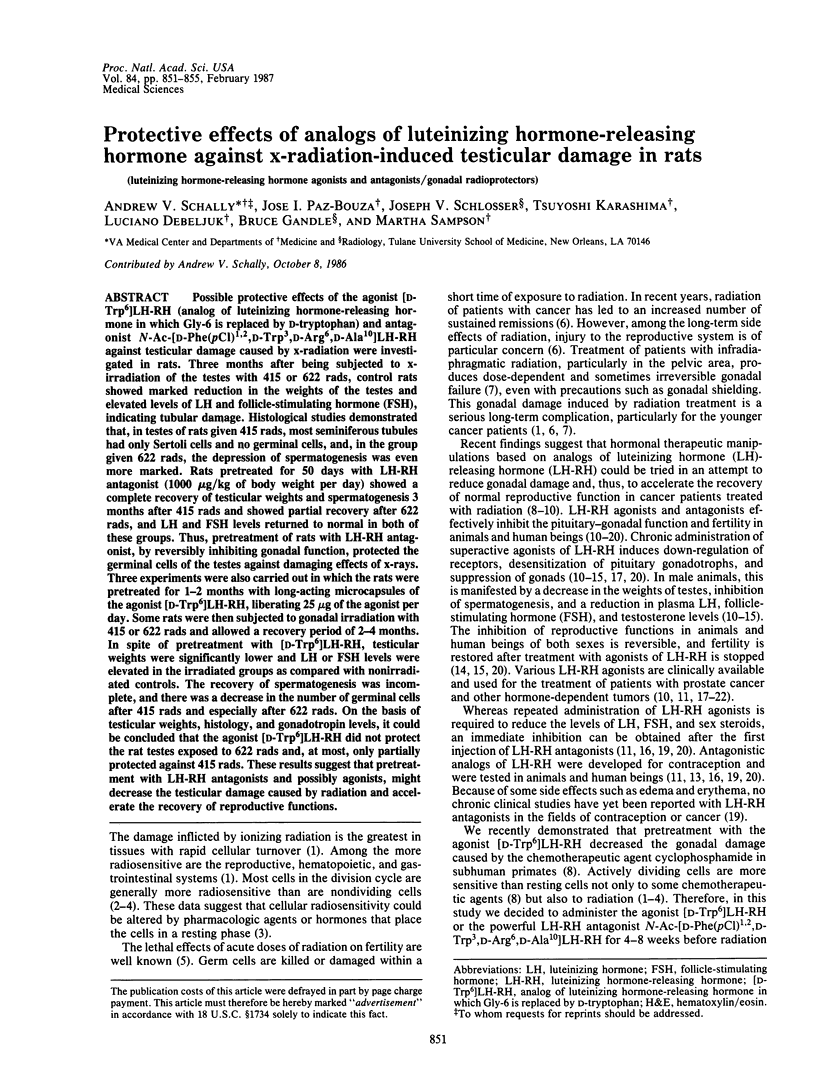
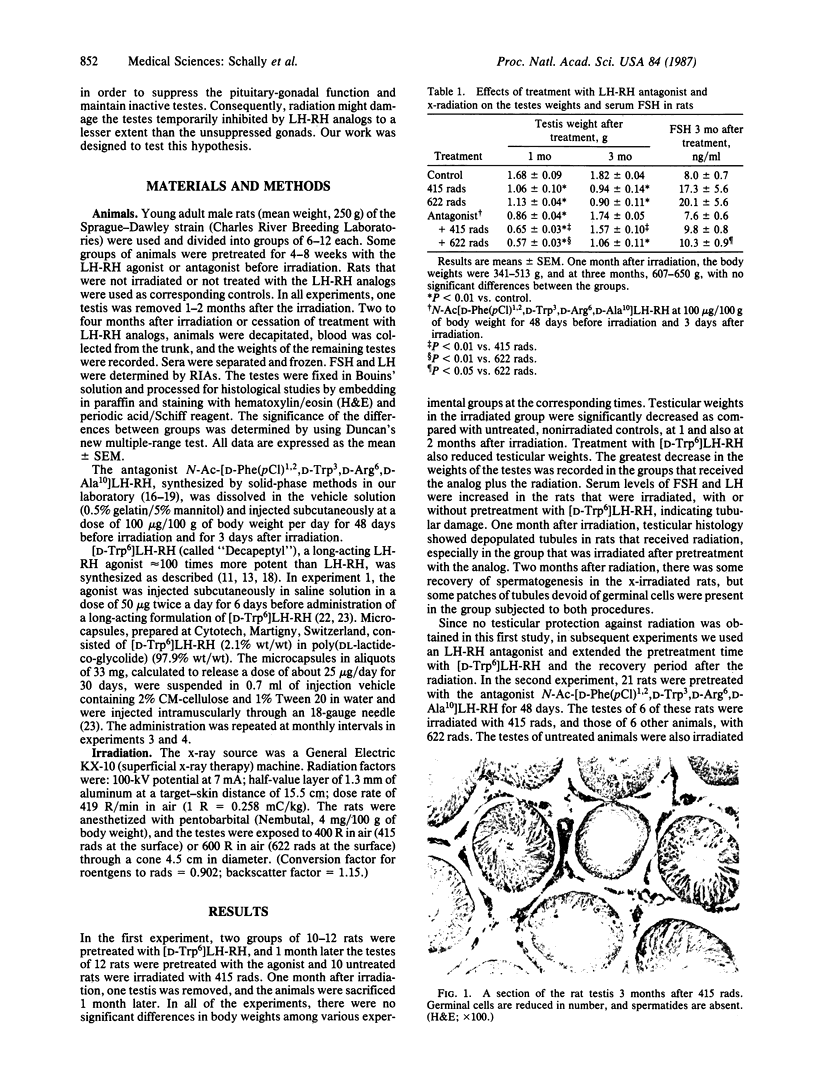
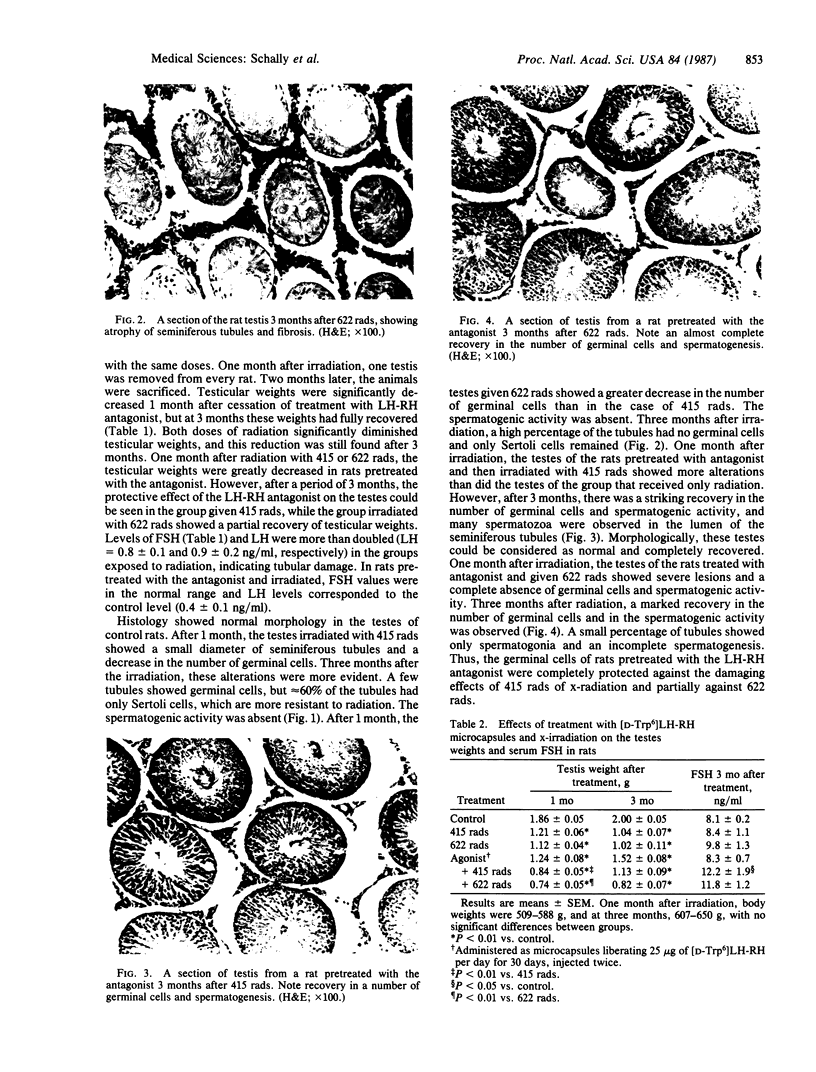
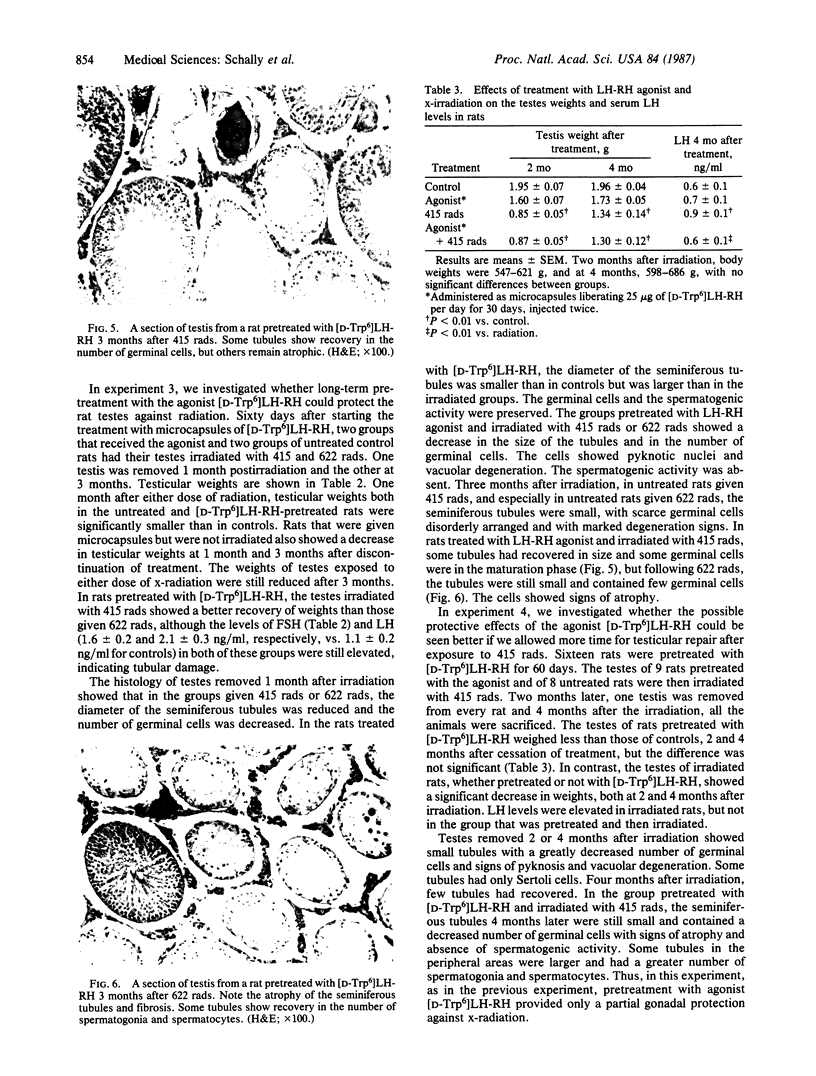
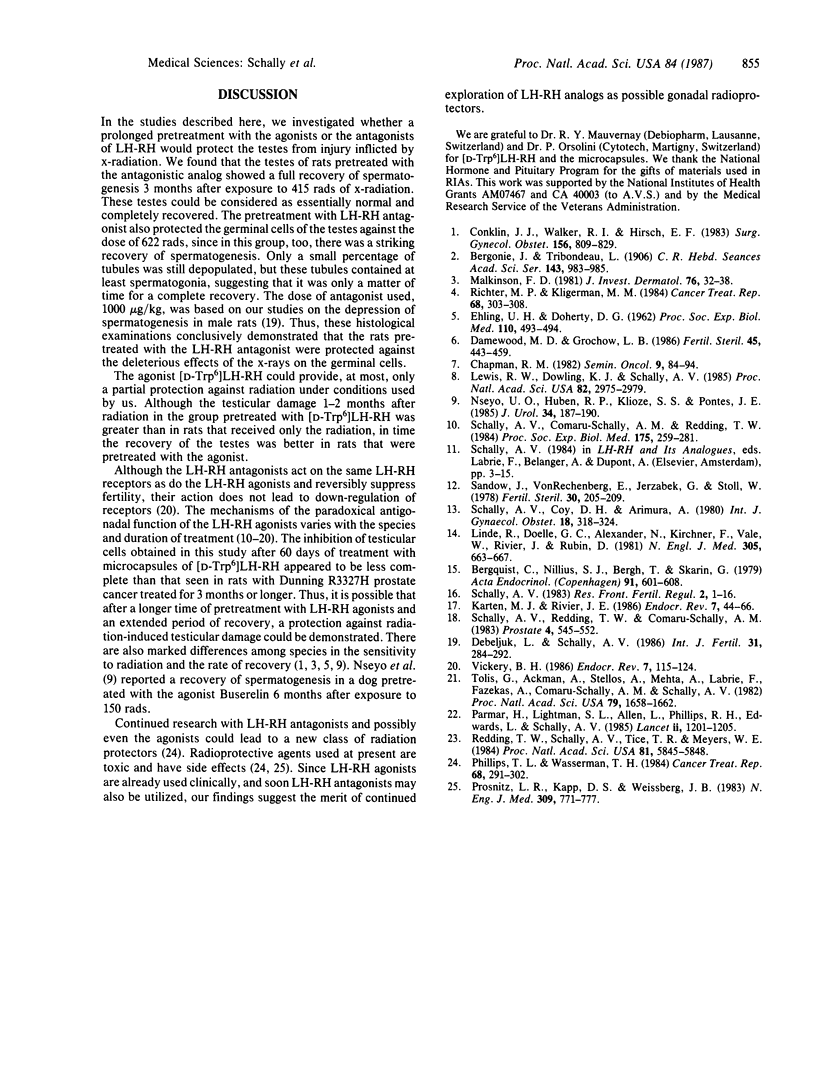
Images in this article
Selected References
These references are in PubMed. This may not be the complete list of references from this article.
- Bergquist C., Nillius S. J., Bergh T., Skarin G., Wide L. Inhibitory effects on gonadotrophin secretion and gonadal function in men during chronic treatment with a potent stimulatory luteinizing hormone-releasing hormone analogue. Acta Endocrinol (Copenh) 1979 Aug;91(4):601–608. doi: 10.1530/acta.0.0910601. [DOI] [PubMed] [Google Scholar]
- Chapman R. M. Effect of cytotoxic therapy on sexuality and gonadal function. Semin Oncol. 1982 Mar;9(1):84–94. [PubMed] [Google Scholar]
- Conklin J. J., Walker R. I., Hirsch E. F. Current concepts in the management of radiation injuries and associated trauma. Surg Gynecol Obstet. 1983 Jun;156(6):809–829. [PubMed] [Google Scholar]
- Damewood M. D., Grochow L. B. Prospects for fertility after chemotherapy or radiation for neoplastic disease. Fertil Steril. 1986 Apr;45(4):443–459. doi: 10.1016/s0015-0282(16)49268-x. [DOI] [PubMed] [Google Scholar]
- Debeljuk L., Schally A. V. Antifertility effects of a potent LH-RH antagonist in male and female rats. Int J Fertil. 1986 Sep-Oct;31(4):284–292. [PubMed] [Google Scholar]
- EHLING U. H., DOHERTY D. G. AET protection of reproductive capacity of irradiated mice. Proc Soc Exp Biol Med. 1962 Jul;110:493–494. doi: 10.3181/00379727-110-27560. [DOI] [PubMed] [Google Scholar]
- Karten M. J., Rivier J. E. Gonadotropin-releasing hormone analog design. Structure-function studies toward the development of agonists and antagonists: rationale and perspective. Endocr Rev. 1986 Feb;7(1):44–66. doi: 10.1210/edrv-7-1-44. [DOI] [PubMed] [Google Scholar]
- Lewis R. W., Dowling K. J., Schally A. V. D-Tryptophan-6 analog of luteinizing hormone-releasing hormone as a protective agent against testicular damage caused by cyclophosphamide in baboons. Proc Natl Acad Sci U S A. 1985 May;82(9):2975–2979. doi: 10.1073/pnas.82.9.2975. [DOI] [PMC free article] [PubMed] [Google Scholar]
- Linde R., Doelle G. C., Alexander N., Kirchner F., Vale W., Rivier J., Rabin D. Reversible inhibition of testicular steroidogenesis and spermatogenesis by a potent gonadotropin-releasing hormone agonist in normal men: an approach toward the development of a male contraceptive. N Engl J Med. 1981 Sep 17;305(12):663–667. doi: 10.1056/NEJM198109173051203. [DOI] [PubMed] [Google Scholar]
- Malkinson F. D. Some principles of radiobiology: a selective review. J Invest Dermatol. 1981 Jul;77(1):32–38. doi: 10.1111/1523-1747.ep12479220. [DOI] [PubMed] [Google Scholar]
- Nseyo U. O., Huben R. P., Klioze S. S., Pontes J. E. Protection of germinal epithelium with luteinizing hormone-releasing hormone analogue. J Urol. 1985 Jul;134(1):187–190. doi: 10.1016/s0022-5347(17)47054-6. [DOI] [PubMed] [Google Scholar]
- Parmar H., Phillips R. H., Lightman S. L., Edwards L., Allen L., Schally A. V. Randomised controlled study of orchidectomy vs long-acting D-Trp-6-LHRH microcapsules in advanced prostatic carcinoma. Lancet. 1985 Nov 30;2(8466):1201–1205. doi: 10.1016/s0140-6736(85)90739-1. [DOI] [PubMed] [Google Scholar]
- Phillips T. L., Wasserman T. H. Promise of radiosensitizers and radioprotectors in the treatment of human cancer. Cancer Treat Rep. 1984 Jan;68(1):291–302. [PubMed] [Google Scholar]
- Prosnitz L. R., Kapp D. S., Weissberg J. B. Radiotherapy. N Engl J Med. 1983 Sep 29;309(13):771–777. doi: 10.1056/NEJM198309293091306. [DOI] [PubMed] [Google Scholar]
- Redding T. W., Schally A. V., Tice T. R., Meyers W. E. Long-acting delivery systems for peptides: inhibition of rat prostate tumors by controlled release of [D-Trp6]luteinizing hormone-releasing hormone from injectable microcapsules. Proc Natl Acad Sci U S A. 1984 Sep;81(18):5845–5848. doi: 10.1073/pnas.81.18.5845. [DOI] [PMC free article] [PubMed] [Google Scholar]
- Richter M. P., Kligerman M. M. Particle-beam radiation therapy 1983: evaluation and recommendations. Cancer Treat Rep. 1984 Jan;68(1):303–308. [PubMed] [Google Scholar]
- Sandow J., Von Rechenberg W., Jerzabek G., Stoll W. Pituitary gonadotropin inhibition by a highly active analog of luteinizing hormone-releasing hormone. Fertil Steril. 1978 Aug;30(2):205–209. doi: 10.1016/s0015-0282(16)43461-8. [DOI] [PubMed] [Google Scholar]
- Schally A. V., Comaru-Schally A. M., Redding T. W. Antitumor effects of analogs of hypothalamic hormones in endocrine-dependent cancers. Proc Soc Exp Biol Med. 1984 Mar;175(3):259–281. doi: 10.3181/00379727-175-41797. [DOI] [PubMed] [Google Scholar]
- Schally A. V., Coy D. H., Arimura A. LH-RH agonists and antagonists. Int J Gynaecol Obstet. 1980;18(5):318–324. doi: 10.1002/j.1879-3479.1980.tb00507.x. [DOI] [PubMed] [Google Scholar]
- Schally A. V. Current status of antagonistic analogs of LH-RH as a contraceptive method in the female. Res Front Fertil Regul. 1983 Jul;2(5):1–16. [PubMed] [Google Scholar]
- Schally A. V., Redding T. W., Comaru-Schally A. M. Inhibition of prostate tumors by agonistic and antagonistic analogs of LH-RH. Prostate. 1983;4(6):545–552. doi: 10.1002/pros.2990040602. [DOI] [PubMed] [Google Scholar]
- Tolis G., Ackman D., Stellos A., Mehta A., Labrie F., Fazekas A. T., Comaru-Schally A. M., Schally A. V. Tumor growth inhibition in patients with prostatic carcinoma treated with luteinizing hormone-releasing hormone agonists. Proc Natl Acad Sci U S A. 1982 Mar;79(5):1658–1662. doi: 10.1073/pnas.79.5.1658. [DOI] [PMC free article] [PubMed] [Google Scholar]
- Vickery B. H. Comparison of the potential for therapeutic utilities with gonadotropin-releasing hormone agonists and antagonists. Endocr Rev. 1986 Feb;7(1):115–124. doi: 10.1210/edrv-7-1-115. [DOI] [PubMed] [Google Scholar]








